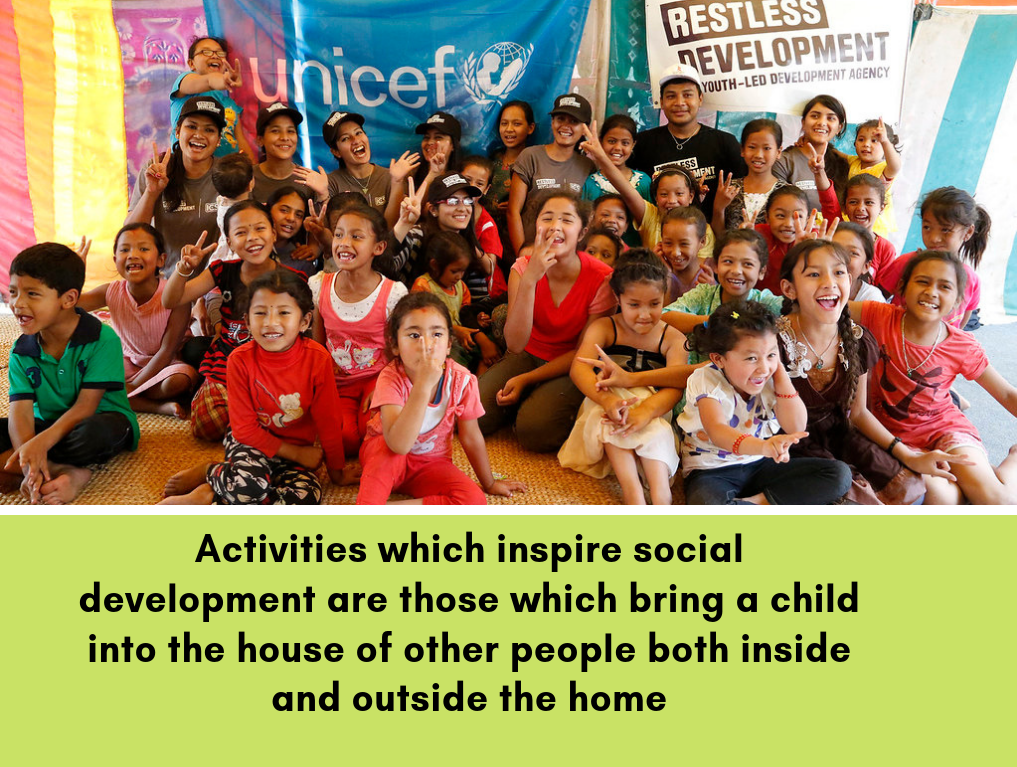Social development-socialization-is the method of culture the abilities and attitudes which enable individuals to live easily with other members of their community.
Social development follows comparable decorations all over the world although social customs differ in different countries and even between different groups in the same country. The difference can be seen in eating habits, standards of hygiene, forms of greeting, attitudes to dress, religion and morals.
Activities which inspire social development are those which bring a child into the company of other people both inside and outside the home, for example:
- Family outing
- Mother and toddler groups
- Playgroups and nursery schools
- Opportunities to play with friends
Social development abilities for the child
Children are happier and better if they get on well with the people around them. It will be easier for them to do this if they are competent in social abilities. These are abilities that make a child more socially acceptable to other people. They include:
- The ability to meet, mix and communicate with others
- Knowing how to share, take turns, and accept rules
- Having standards of cleanliness acceptable to others, e.g. washing, using the toilet
- Eating in a manner that does not offend others.
Children are not born with a knowledge of these social skills. They have to learn them. If the parents do not teach them, how will they learn?
A pattern of social development for child
New-born children are social beings right from the start. They have an inborn need for the company of other people. They cry if they are lonely and can be supported by being held close to another person.
The baby begins to interact with other people
2 weeks: The baby watches his mother’s face as she feeds and talks to him and he soon comes to recognize her.
4-6 weeks: The baby begins to smile. He will then smile to show pleasure when people look at him.
3 months: When an adult speaks to the baby, he will respond by making noises, conversations with people.
6 months: The baby is beginning to understand how to attract attention, for example, by a cough. He learns how to make people do what he wants- at least on some occasions.
The baby learns that he is part of a family
9 months: He distinguishes strangers from people he knows and needs the reassuring presence of a familiar adult to overcome shyness and anxiety.
The child learns to co-operate as a member of a group
1 year: He understands and obeys simple commands.
15 Months: He copies and helps adults in the house and garden.
2 years: He likes to play near other children, but not with them, and defends his possessions with determination. He will show concern for other children in distress.
3 years: He plays with other children and understands sharing.
4 years: He needs other children to play with but his behavior is alternately co-operative and aggressive.
5-7 years: He co-operates with his companions and understands the need for rules and fair play.
Learning to say thank you
When people say thank you they are expressing their gratitude for something which has been done for them.
Young children have no understanding of the efforts of others and it is not natural for them to say thank you. But if they are taught to be grateful for what other people do for them, and to say thank you it will make more pleasant to live with.
Loneliness
The child who does not have sufficient social contact, that is does not have enough people and friends to talk to and play with, will feel lonely. Feeling lonely over a long period of time can make a child unhappy and slow down development.
Adults who are cut off from sufficient contact with other people can also feel lonely and perhaps depressed as well. This sometimes applies to mothers of young children. The remedy is for the mother to find ways in which she can meet and mix with more people. If these people also have young children, then her own child will benefit from more company as well as from a happier mother.
Development of social play
Between the ages of 1 and 5 years, children show a gradual development from simple to more complicated forms of social play. Most children pass through the following stages as they learn to play together in groups.
- Solitary play: Playing alone.
- Parallel play: Playing alongside others but not with them
- Looking-on play Watching from the edge of the groups as other children play
- Joining-in play: Playing with others by doing the same thing as everybody else, for example, running around together, or playing with dolls as in the drawing
- Co-operative play: Belonging to a group and sharing in the same task, for example, doing a jigsaw together, or cooking, or playing with a rope, as in the drawing.




I used to be recommended this web site by means of my cousin. I am now not sure whether or not this put up is written by way of him as no one else recognize such distinctive about my problem. You’re incredible! Thanks!
There is noticeably a bundle to know about this. I assume you made certain nice points in features also.